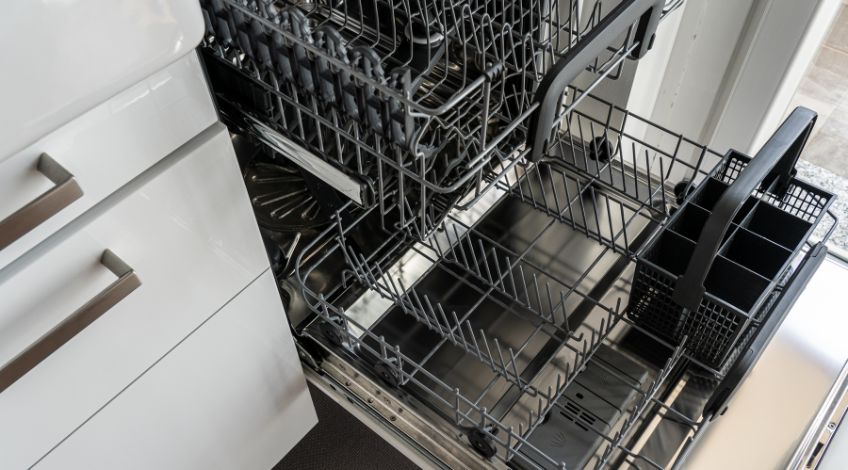
How To Clean & Sanitise A Dishwasher (to remove smells & dirt)
It might sound a bit daft to clean a dishwasher when it’s constantly running using hot water and detergent. But the reality is, dishwashers get dirty and smelly over time if they’re not looked after properly.
In this article we look at ways to ensure your dishwasher is always kept clean as well as odour and germ free.
Why Does A Dishwasher Get Dirty?
If you were to stop and think about it, you’d soon realise just how dishwashers get dirty and smelly. You see every dirty dish, plate and pan you put in your dishwasher carries food particles.
These food particles get washed away (for the most part) and leave the dishwasher through the drain hose. The problem is, that over time, the filter gets clogged which can prevent some of these food particles from leaving the appliance during the wash and rinse & drain cycles.
This can lead to pieces of food and grease etc remaining in the dishwasher where germs and bacteria can breed on them which is where the smell comes from.
How To Clean & Sanitise Your Dishwasher

Let’s get into the best way to remove germs, dirt and bacteria from your dishwasher.
Cleaning The Door
Every time you load dirty dishes into your dishwasher you run the risk of food particles falling onto the door. Many of these become lodged in the various nooks and crannies of the door of your dishwasher and build up over time.
The best way to ensure all of these food particles are removed is to wipe the door, rim, handles and controls using a damp cloth or sponge.
Removing Food Particles Before Loading The Dishwasher
It’s a good idea to always remove any loose food particles from your dishes before placing them in your dishwasher. This allows the dishwasher to get your dishes cleaner and also prevents so many food particles from remaining in your dishwasher after the cycle has finished.
Once the cycle has finished and you have emptied your dishwasher, it’s a good idea to remove the lower rack and wipe away any food residue that’s left behind using a damp cloth or sponge.
Clean The Dishwasher’s Filter
The filter on your dishwasher is there to collect any food particles and prevent them from running back into the appliance and soiling your now clean dishes.
Over time, those food particles build up on the filter and can eventually block it causing all manner of problems. But even before the filter gets completely clogged, it could become a breeding ground for germs and bacteria which will lead to bad smells.
You should remove the filter (check with your handbook first as not all filters are removable) and using a brush and warm water, remove all visible dirt and food particles from the filter.
Replace the now clean filter back into its housing and remember to perform this task at least once a week to ensure your dishwasher remains germ & bacteria free.
Clean The Dishwasher Using A Service Wash
Once you have cleaned the door and the filter, it’s a good idea to clean the actual dishwasher to ensure it runs smoothly. You can buy a proprietary dishwasher cleaner and use it as per the instructions on the packaging.
Alternatively you can opt for the natural option which uses white vinegar and bicarbonate of soda.

How to Use White Vinegar & Bicarbonate Of Soda To Clean A Dishwasher
To clean your dishwasher using white vinegar & bicarbonate of soda all you need to do is;
- Ensure all dishes etc have been removed from your dishwasher.
- Place one cup of white vinegar in a dishwasher safe bowl on the top rack of your dishwasher.
- Run a hot water cycle (this will break down any residue and deodorise your dishwasher).
- After this cycle has finished, remove the bowl and spread one cup of bicarbonate of soda on the bottom of the dishwasher.
- Run a short hot cycle (this will dissolve any grease etc).
- Once this cycle has finished your dishwasher should smell fresh and be completely germ & bacteria free.
Please Note: It’s important that you only use distilled white vinegar to clean your dishwasher because any coloured vinegar has the potential to stain your dishwasher.
You should never put vinegar in the rinse aid dispenser as this could compromise the integrity of the seals and gaskets of this compartment
How Often Should A Dishwasher Be Cleaned?
Now that your dishwasher is clean and germ & bacteria free, you’re going to want to keep it that way. The best way to achieve this is to get into the habit of cleaning your appliance on a regular basis.
- You should always try to remove any loose food, sauce, gravy, etc from your dishes before placing them in the dishwasher.
- After loading the dishwasher, you should check there are no food particles on the door etc.
- You should clean the filter once a week.
- You should run a service wash at least once a month (more often if you use your dishwasher every day and often have greasy foods).
SEE ALSO: Can You Leave Clean/Dirty Dishes In The Dishwasher Overnight?
Frequently Asked Questions
You do need to sanitise your dishwasher because it can get a build up of food, grease and other debris that can become a breeding ground for bacteria & germs. Cleaning your dishwasher also ensures the appliance runs as it should and reduces the frequency of any filter/drainage related problems.
You should sanitise your dishwasher at least once a month to ensure it is germ and bacteria free.
You should put one cup of distilled white vinegar in a dishwasher safe bowl on the top rack of the dishwasher and run a hot wash cycle.
Also, follow us on Pinterest ...



